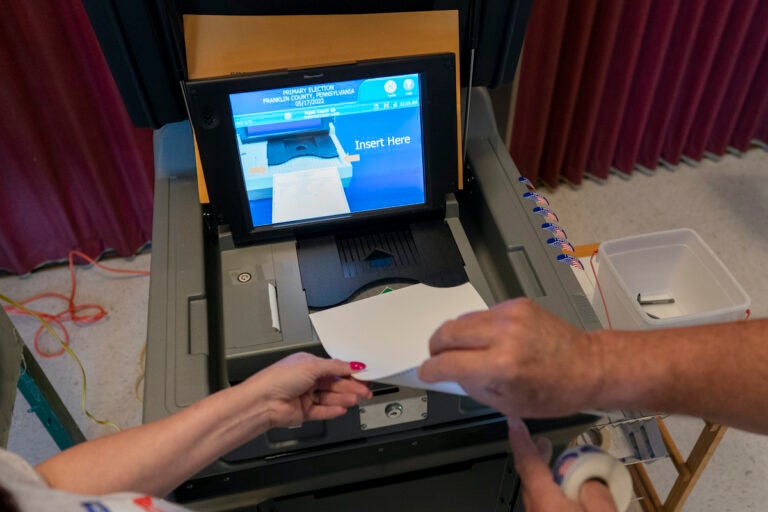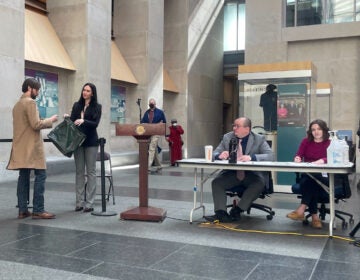Pa. court rules electronic voting data is not subject to release under public records law
The 5-2 ruling sides with Secretary of State Al Schmidt, whose office argued against access to these electronic records from Lycoming County for the 2020 General Election.

Voter-by-voter electronic election records are not subject to public scrutiny, a Pennsylvania court ruled Monday, March 4, 2024, in a case that began with a request for those records by an election researcher whose work has fueled right-wing attacks on voting procedures. (AP Photo/Carolyn Kaster, File)
Spreadsheets of raw data associated with every ballot cast are not subject to public scrutiny, a Pennsylvania court ruled Monday in a case that began with a request for the “cast vote records” by an election researcher whose work has fueled right-wing attacks on voting procedures.
Commonwealth Court ruled 5-2 in favor of Secretary of State Al Schmidt, saying that researcher Heather Honey and others were not entitled to the records from Lycoming County for the 2020 General Election.
Pennsylvania’s Elections Code says county election records are public “except the contents of ballot boxes and voting machines and records of assisted voters.” The law does not define voting machines, however.
Honey’s October 2021 request under the state’s Right-to-Know Law was turned down by the county elections office, a decision upheld by the state Office of Open Records before a Lycoming County judge ruled the public is entitled to the records.
The Commonwealth Court majority ruled Monday that cast vote records are the “electronic, modern-day equivalent” of all the votes in a traditional ballot box and the optical scanners are considered voting machines under state law.
Because Honey did not live and vote in Lycoming County, she was succeeded in the litigation by three Williamsport area residents — a local businessman, a retired state trooper and Republican state Rep. Joe Hamm.
Their lawyer, Thomas Breth, said Monday a decision had not been made about whether to appeal to the Pennsylvania Supreme Court.
“We respectfully disagree with the majority of the court’s interpretation of the Election Code,” Breth said.
The county judge said in December 2022 that optical scanners used to record Lycoming votes that had been cast on paper ballots did not qualify as voting machines under state law. The judge said that the contents of ballot boxes or voting machines, information that the law shields from public disclosure, amount to the ballots and the mechanisms of voting machines, rather than information contained in those machines such as electronic data.
Judge Ellen Ceisler’s majority opinion concluded that Lycoming’s optical scanners “are undoubtedly mechanical, electrical, electromechanical, or electronic components of a voting system that are specifically used for the task of voting, including with regard to the casting and tabulation of votes. Therefore, these devices also fit the generally understood definition of ‘voting machines.’”
She said it would be absurd if the physical ballots were not available for public inspection “but digital analogues of those very same ballots were freely available upon request, as what is special about the ballots is not so much the form which they take, but the voting information which they contain.”
Breth said releasing the data would not enable anyone to pierce the secrecy of ballots.
“The court’s decision, I don’t believe, was based upon any theory that you could reverse engineer the data and identify how somebody voted,” Breth said.
The Department of State’s press office said it was working on a response to the ruling.
In a dissent, Judge Patricia McCullough said the cast vote records don’t associate a ballot with a specific voter.
“The order of the numbered list of voters does not even correspond to the order in which ballots are cast,” McCullough wrote. “The only way a person could determine an elector’s ordinal position is by personally observing that elector cast his or her ballot.”
Honey, who heads the Lebanon, Pennsylvania-based firm Haystack Investigations, had previously likened the cast vote record to a spreadsheet and described it as “merely a digital report tallying the results of ballots scanned into a tabulator. The CVR is a report that is prepared after an election from a desktop computer that is not and never was the contents of a ballot box.”
WHYY is your source for fact-based, in-depth journalism and information. As a nonprofit organization, we rely on financial support from readers like you. Please give today.





